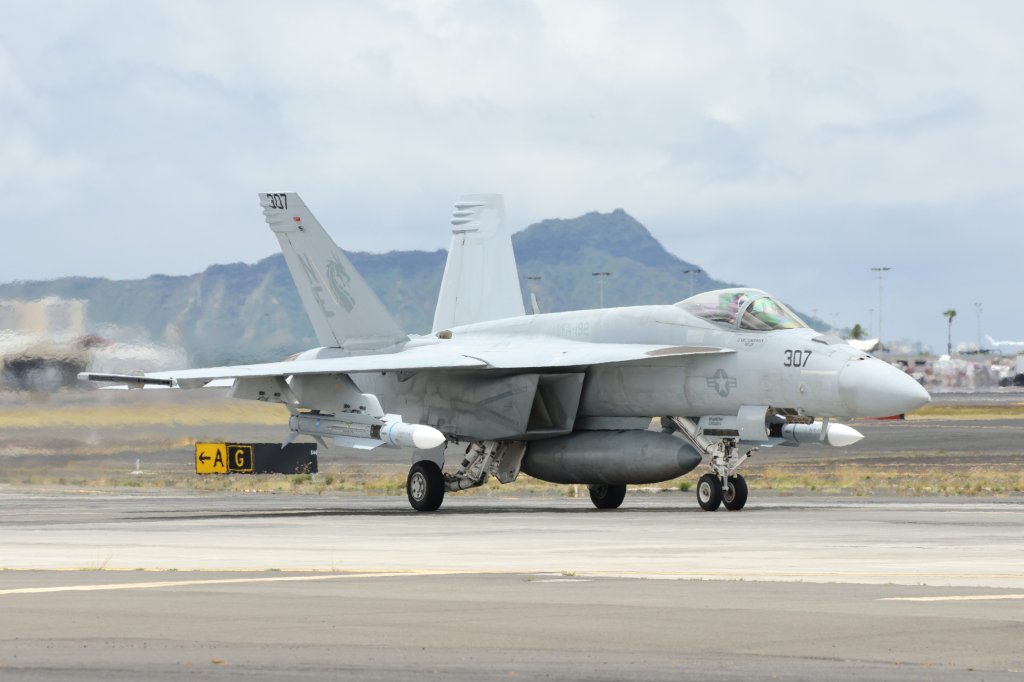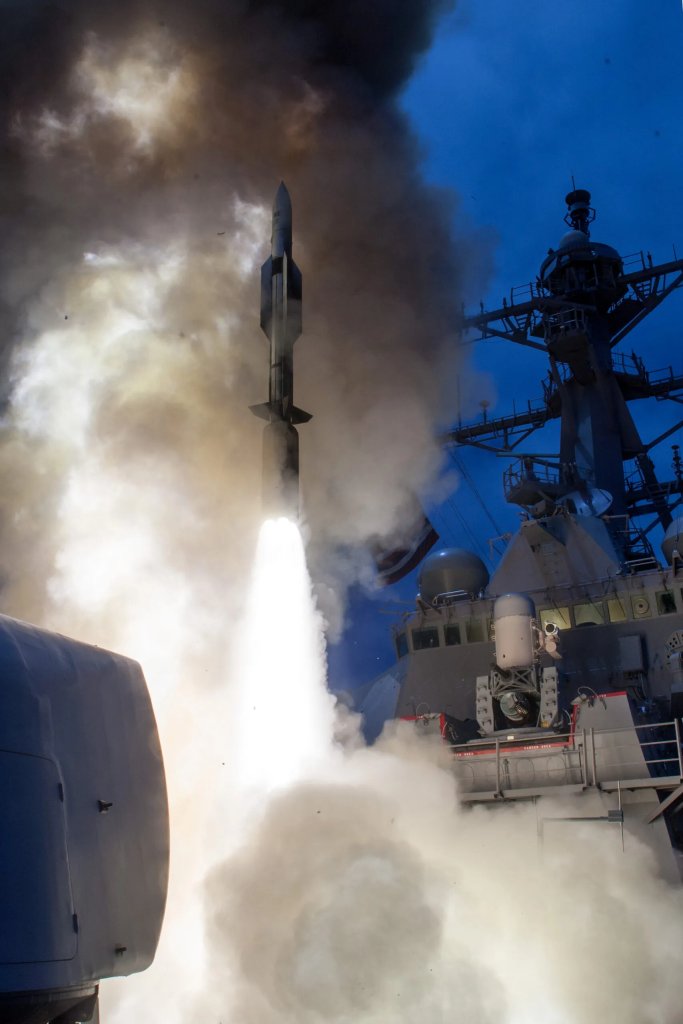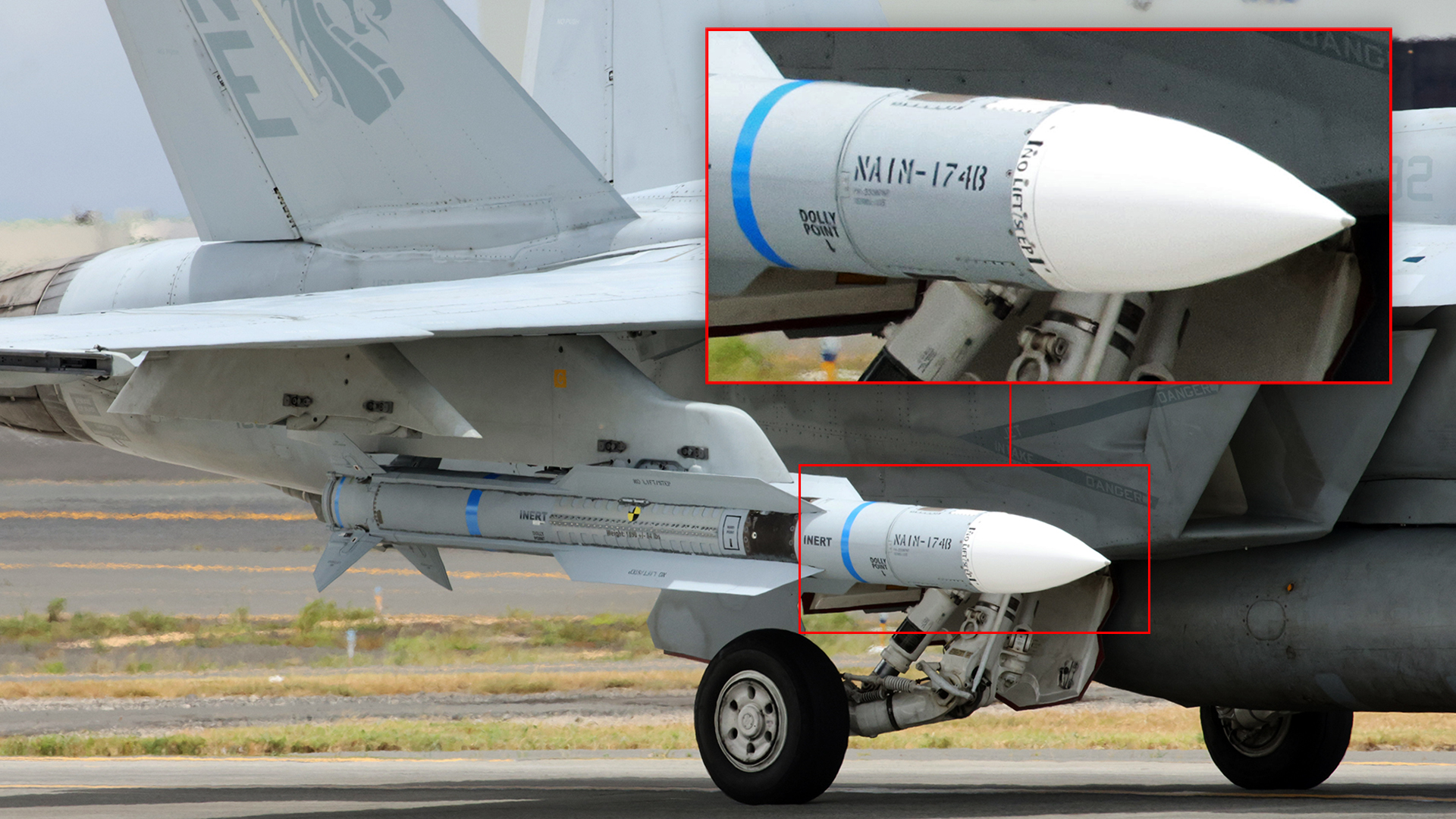We can say with confidence that a weapon with massive potential and huge tactical repercussions that we knew existed for years now — at least for undisclosed conceptual testing purposes, but which has gone totally unacknowledged by the U.S. Navy — is indeed more than just an isolated enigma. Not only that, we now also know its official designation.
The air-launched version of the hugely versatile SM-6 missile, also known as the RIM-174, has appeared on U.S. Navy F/A-18E/F Super Hornet fighters at the biennial Rim of the Pacific (RIMPAC) exercise, the world’s largest international maritime exercise. The missiles are clearly sporting the designation AIM-174B, indicating a (very long-range) air-to-air missile, although, as we have discussed in the past, the weapon also has the potential to strike high-priority ground targets, such as air defense sites, and warships, acting as a quasi-ballistic missile. You can read what we previously knew about this phantom of a missile in this previous report.

Photographer aeros808 spotted an F/A-18E from Strike Fighter Squadron 192 (VFA-192), the “Golden Dragons,” at Joint Base Pearl Harbor-Hickam, Hawaii, yesterday, carrying a pair of these missiles in training-round form. The unit is currently deployed as part of Carrier Air Wing 2 (CVW-2) aboard the aircraft carrier USS Carl Vinson (CVN-70).
As well as this jet, aeros808 told us that another Super Hornet, from VFA-2 “Bounty Hunters,” also attached to CVW-2, was seen yesterday, as well, as part of a two-ship flight with the VFA-192 jet. Each aircraft carried a pair of NAIM-174Bs, with the prefix letter N indicating that these missiles were modified for special tests.

The missiles themselves — which have the NAIM-174B designation prominently applied at the forward end — are painted gray, in contrast to the previous, orange-colored examples we have seen in the past. The missiles are marked as inert (meaning no warhead is fitted) and also carry blue bands to denote this and that they do not have a live motor. A black and yellow marking close to the center of the missile body appears to be a calibration marking — making it easier to study the behavior of the missile after it is released or for captive-carry tests.
The fact that these missiles have appeared during RIMPAC is intriguing, to say the least. This may be indicative of tactics testing, but it could also suggest that a live AIM-174B may be used as part of a live-fire exercise. This could be in the air-to-air role, but we also believe that the ex-USS Tarawa, a decommissioned U.S. Navy amphibious assault ship, is likely to be sunk off the coast of Hawaii during the exercise. This would be a significant occurrence, being the first time in more than a decade that a big-deck amphibious assault ship of any kind is sent beneath the waves in a U.S.-led SINKEX exercise.

If the AIM-174B retains the surface strike capability of the SM-6, as we have posited in the past, and live missiles do exist at this time, the opportunity to test it against a target of this size during a major multinational live-fire event could be very useful and it would send a powerful message to adversaries.
We have reached out to the U.S. Navy for more details on what is, so far, a very shadowy program.
The Super Hornet and SM-6/AIM-174B combination was first spotted three years ago but, as we mentioned earlier, it has never been officially acknowledged by the Navy.
In April this year, more photos emerged of the missile carried by an F/A-18E/F north of Naval Air Weapons Station China Lake, California, on April 17. On this occasion, the aircraft was from Air Test and Evaluation Squadron (VX) 9, or possibly VX-31.
Clearly, the missile has been under test or at least under conceptual evaluation for a long time now. The fact that fleet aircraft are now seen carrying them — although test pilots could still potentially be at the controls — in their new standard colors also points to this capability maturing into an operational one.
We still don’t know, however, what kinds of targets the AIM-174B is primarily intended to counter, although its designation is telling. Air-to-air is clearly a key capability, but what about the other, secondary abilities of the SM-6?
The surface-launched SM-6 was originally designed to tackle air-breathing aerial threats at long ranges as well as ballistic missiles in their terminal stages of flight. Now it also has a capability against hypersonic weapons, under specific circumstances.
The ability for the standard SM-6 to be used against high-priority ground and sea targets is a huge value add. This capability could well also extend to the AIM-174B, which would put it in the quasi-ballistic missile class, a category of weapon that is becoming increasingly relevant in the air-launched realm.

The SM-6 is also ‘networked’ with the ability to receive critical data from an array of platforms that can provide remote targeting that is not organic to the missile’s launch platform. In this sense, it would be able to exploit the various benefits of the Naval Integrated Fire Control-Counter Air concept, or NIFC-CA, which is increasingly bringing together the complementary capabilities of platforms such as the F-35 stealth fighter, E-2D Advanced Hawkeye radar plane, Aegis-equipped warships, and weapons like the SM-6. For example, this architecture should allow a Super Hornet to use the AIM-174B to engage targets that are beyond the range of its own radar as well as target sets that it cannot otherwise handle, like ballistic missiles.
As an air-to-air weapon, the AIM-174B would provide the Super Hornet with the ability to engage a wide variety of aerial threats at distances of over hundreds of miles, a significant advantage over the current AIM-120 AMRAAM and likely also beyond the range of the still-in-development AIM-260 JATM. Air launch at speed and altitude by a fighter means it will have significantly greater range and enhanced kinematics over the surface-launched variant, although it does not have the booster that the standard SM-6 utilizes. The surface-launched SM-6’s range is currently thought to be around 230 miles, but this depends on many factors, including the mode in which it is being used.
Such a long-range missile would be a huge advantage considering China is now fielding its own very long-range air-to-air missiles. Using AIM-174B against airborne early warning, reconnaissance, maritime patrol, aerial refueling, and bomber/cruise missile carrier aircraft at extreme ranges would be a major enhancement in the Navy’s air combat capabilities and a huge threat to these lumbering enemy aircraft. This would be one key way the U.S. could help counter a portion of China’s looming anti-access infrastructure.

Against ground or maritime surface targets, the AIM-174B would also give the Super Hornet a means of striking over considerable distances with a weapon that is notably hard to intercept. Reaching a velocity close to or in excess of hypersonic speed during the terminal stage of its flight makes the missile a major challenge to defend against. That same speed means that it also hits very hard and can be used against some fortified target sets.
We do have to also make clear that this missile could be used as a training and testing surrogate, to emulate an adversary’s capabilities, such as an air-launched ballistic missile. While this is quite possible, the designation surely doesn’t point in that direction nor does the secrecy that has surrounded the program. Still, an air-launched SM-6 could also serve as a surrogate threat target as well as an operational weapon.
Clearly, these kinds of capabilities would be extremely relevant to a future potential conflict with China in the Pacific, which the U.S. military expects to be dominated by very long-range ‘kill chains,’ something that is sure to be demonstrated during this iteration of RIMPAC.
The bottom line is that this latest development strongly suggests that an air-launched version of the SM-6 is either an operational reality or it’s close to becoming one. If that ends up being the case, the Navy is about to realize a major capability leap.
UPDATE: 3:00 PM EDT —
One of the eagle-eyed members of our commenting crew, @nukepopcorn, gave us the heads up that AIM-174 was displayed mounted on a Super Hornet aboard the USS Carl Vinson this week and it was captured in a video taken during a tour of the supercarrier while docked in Pearl Harbor. You can see the Super Hornet in question, an F/A-18E from VFA-113 Stingers, configured for air-to-air combat, sporting AIM-9Xs and AMRAAMs as well as the AIM-174s. The fact that the Navy is openly displaying this weapon, even if in captive carry form, is telling and increases the likelihood of official comment on the capability soon.

Contact the author: thomas@thewarzone.com
